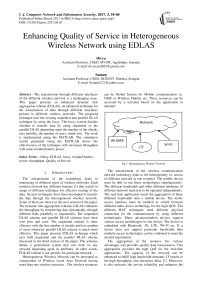Enhancing Quality of Service in Heterogeneous Wireless Network using EDLAS
Автор: Divya, Suman
Журнал: International Journal of Computer Network and Information Security(IJCNIS) @ijcnis
Статья в выпуске: 3 vol.9, 2017 года.
Бесплатный доступ
The transmission through different interfaces of the different wireless network is a challenging issue. This paper presents an enhanced dynamic link aggregation scheme (EDLAS), an enhanced technique for the transmission of data through different interfaces present in different wireless networks. The proposed technique uses the existing sequential and parallel DLAS technique by using the fuzzy. The fuzzy system decides whether to transfer data by using sequential or the parallel DLAS depending upon the number of the chunks, user mobility, the number of users, chunk size. The work is implemented using the MATLAB. The simulation results generated using the MATLAB shows the effectiveness of the technique with increased throughput with same residual battery power.
Delay, EDLAS, fuzzy, residual battery power, throughput, Quality of Service
Короткий адрес: https://sciup.org/15011823
IDR: 15011823
Текст научной статьи Enhancing Quality of Service in Heterogeneous Wireless Network using EDLAS
Published Online March 2017 in MECS DOI: 10.5815/ijcnis.2017.03.07
The advancement of the technology leads to interfacing of different types of wireless networks. Each wireless network has different features [1] that results in usage of different technique for effective routing of the data. Several techniques have been developed to transfer the data through the heterogeneous wireless network. Some of them are shown in the next section of the paper. The dynamic link aggregation schemes (DLAS) enhances the throughput by transferring data dynamically through different links parallelly or sequentially. The sequential DLAS scheme and parallel DLAS schemes have their own pros and cons. The sequential scheme is more effective with the less number of chunks and less number of users otherwise parallel DLAS scheme is much more effective. This paper presents EDLAS technique which uses both sequential and the parallel DLAS scheme discussed in the third section of the paper. The schemes define a generalized system that can work on any network depending upon its attributes. In other words, EDLAS scheme is not specific for particular network.
Heterogeneous Wireless Network can be presented as composition of Wireless Local Area Network having more than one wireless resources . The wireless resources can be Global System for Mobile communication i.e. GSM or Wireless Fidelity etc. These resources can be accessed by a terminal based on the application in demand.
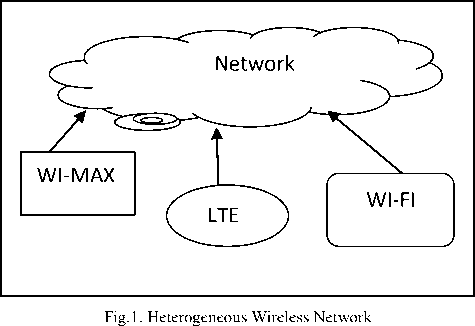
The advancement in the wireless communication network technology leads to the heterogeneity i.e. access of different network at one terminal. The mobile device must be able to use these technologies simultaneously. The different bandwidth and other different attributes of different network need tem to be operated independently. The real time application needs the aggregation of these different bandwidth onto a mobile device. The multiaccess interface must be enabled to switch between different radio access technology for the high QOS. The different RAT techniques need different physical connection for the communication by using different technologies. Many advance/modern devices support various access technologies in one device. The device is embedded with Bluetooth, 3G, LTE, WI-FI etc. If a device does not support particular bandwidth then multiple access technologies can be combined to meet the desired requirement.
The aggregation of the resource has various advantages and provides quality data transmission. This aggregation provides the high QoS for the real-time applications. The capacity of the network can be enhanced to fulfill high bandwidth demands. IT results in the high throughput, also decreases delay [1]. Moreover, it also increases the service reliability and enhances the fault tolerance. Fig1 shows a heterogeneous wireless network that is connected by different radio access technologies. The different access devices are GSM WIFI and WIMAX based. The rest paper is divided into three sections. The Literature survey is presented in first section. Section second presents proposed technique. The third section covers the implementation of the proposed scheme with result discussion.
-
II. Related Work
Danyu Zhu et al. [2] proposed a data aggregation technique that work on the wired as well on wireless interface to enhance the QOS. Puneet Sharma et al. [3] implemented a system that work on bandwidth aggregation to provide high-speed Internet. The authors demonstrated that the designed system improve the service quality, also some unachievable services get achieved. B. K. Gupta et al. [4] proposed a simple technique for handover in ATM based PCN network. The hybrid scheme enhances the QoS. Anthony J. Saliba et al. [5] shows that the pre-determined QOS values can be used to determine the network parameters for useful applications. Kameswari Chebrolu et al. [6] present a architecture that uses the Earliest Delivery Path First to deliver the packet from source to destination within the deadline. The scheduling algorithm enables the multiaccess applications. Sylwia Romaszko et al. [7] presented the three algorithms dynamically selecting a lower, upper or both bounds of the CW interval. All these approaches outperform the IEEE 802.11 DCF standard in terms of total number of packets received, the number of collisions, the lifetime of the network, the dead of the first node, and slightly the average delay. Patil, S. et al. [8] proposed a scheduling and resource allocation scheme that allows base station to serve a mixture of real-time and best-effort users. The proposed scheme realizes probabilistic QoS guarantees over short time scales to real-time users while exploiting both intra- and interclass opportunism across users. Jin, N. et al. [9] investigated whether congestion-based pricing can be used to control aggregate traffic into each code point by motivating users to choose the code-points appropriate for each application. Elias Z. Tragos et al. [10] survey the existing control schemes for the 2G as well for 3G network. The author also give a design of control scheme for the 4G applications. Kirubakaran.S et al. [11] studied the resource management within the network. The authors uses the priority based access to proper manager the resources..
Abhishek Mairh et al. [12] proposed the system level Quality-of-Service (QoS) at the data link layer. This system level QoS is designed to guarantee the drop rate in wireless cellular networks. R K Jha et al. [13] have implemented a scheme for the VOIP with higher throughput and decreased delay. The schemes usefulness is also discussed in the paper. K. Sakthi Mala et al. [14] proposed a new cross layer feedback mechanism, which identifies wireless losses and inform TCP. TCP recovers such losses immediately, which normally would lead to slow-start. Wahida Mansouri et al. [15] designed a technique that distributes the end-to-end delay in any heterogeneous networks. Their proposed method preassign a threshold delay value for each network along with the routing path. This leads to the calculation of maximum allowable end-to-end packet delay in any network. The simulation results evaluated over different network size have better performance. Jun Huang et al. [16] discussed two efficient routing algorithms. They also analyzed their computational performance over open test bed. The theoretical analysis as well as the experimental results shows the effectiveness of the proposed routing algorithms. Duc Hoang Bui et al. [17] presented, an energy-efficient scheme that performs bandwidth aggregation and supports real-time data-streaming services. These services are supported over asymmetric as well as on symmetric wireless links without any modifications in existing Internet infrastructure. Bala Murali Krishna K et al. [18] proposed a simple and application layer Scheme that aggregates data which can be easily and dynamically transferred by using multiple links either parallelly or sequentially. They achieved 65 % improvement over existing throughput as compared to existing application layer technique.
It is very much clear from above discussion that the most effective technique that exists is DLAS. In the DLAS technique [8] firstly a request is sent on each interface and the throughput is calculated by using the delay occurred on each interface as Thi (Ij ) = (N ch (Ij) * Ch size ) / RTD where N ch is the number of chunks, Ch size is the chunk size and RTD is the round trip delay. The throughput on each interface is used to evaluate the number of chunk to be sent on each interface as number of chunks are directly proportional to overall throughput.
The overall throughput is evaluated as: Thov(Ij) = Y * Th old (Ij) + (1- Y) * Th i (Ij) where Y = 0.3. This step delay is used to evaluate the throughput. Then in the next interfacing depends upon this throughput. The process continues until all chunks have been sent. These chunks are sent on parallel connections if PDLAS is used otherwise chunks are sent sequentially on one connection. In the SDLAS the chunk is sent on the request from the user. While in case of PDLAS the chunk is divided in to sub chunks as shown in Fig 2. Then each sub chunk is sent parallel on each connection to transfer the data to the other end. Each sub chunk follow the process described above to reach the required destination.
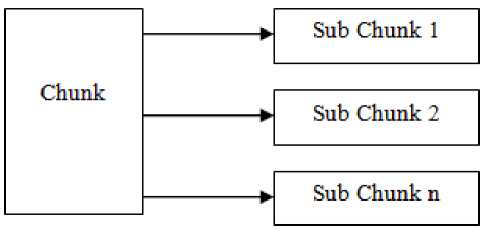
Fig.2. Fragmentation of Chunk
The PDLAS can be easily understood by the following flow diagram shown in Fig 3.l
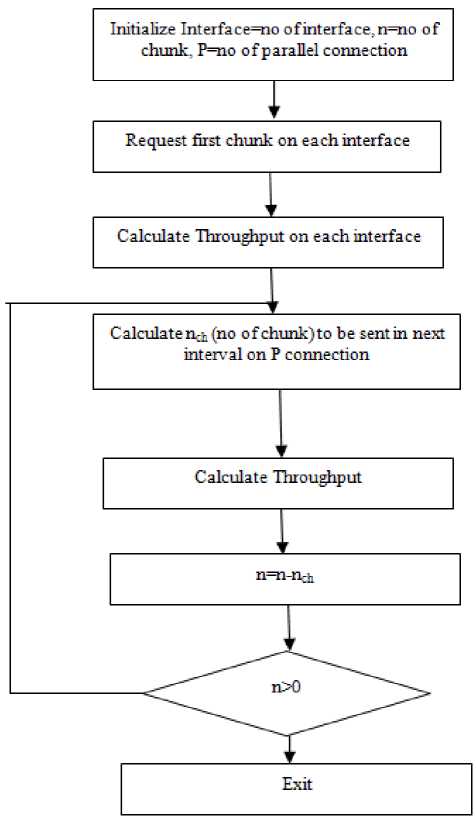
Fig.3. PDLAS Flowchart
The process of SDLAS is similar to the PDLAS except the chunk is transferred sequentially on a single connection.
-
III. Proposed Technique
The proposed technique EDLAS is the combination of SDLAS and PDLAS and uses Fuzzy system. There are two types of fuzzy models: Mamdani and Sugeno. EDLAS uses Mamdani fuzzy model. This process uses the Mamdani fuzzy model. The fuzzy system takes decision depending upon four input parameters which are mobility, chunk size, number of chunks and the number of users. The fuzzy inference engine provides the output based on the rules given the table 1. The output of the fuzzy is compared with a fixed threshold value. If the threshold value is greater than the output of the fuzzy system then system performs the sequential DLAS otherwise system performs PDLAS. The range of four input parameters fed to fuzzy system is given in table 1:
Table 1. Fuzzy Parameters
|
Parameter Name |
Parameter Type |
Range |
Fuzzy Values |
|
Mobility |
Input |
10 100 |
L,M,H |
|
Number of chunk |
Input |
0-100 |
L,M,H |
|
Number of User |
Input |
10 100 |
L,M,H |
|
Chunk Size |
Input |
0-100 |
L,M,H |
|
Selection Probability |
Output |
0-1 |
L,M,H |
The membership functions of the input/output parameters described in the table 1 are shown in Fig 4 to Fig 8.
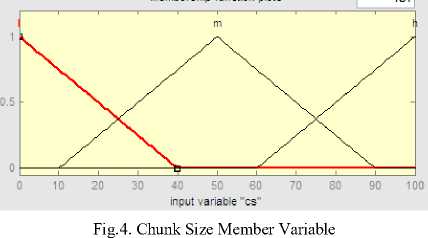
The chunk size input variable having the range 0-100 is shown in the Fig 4. The chunk size has l, m, h (low, medium, high) as its linguistic values. The mapping of the l, m, h values with the physical values can be easily determined by the Fig 4 i.e. less than 40 for l, 40-60 for the m and greater than 60 is h. Here l denotes low, m medium and the h denotes the high size.
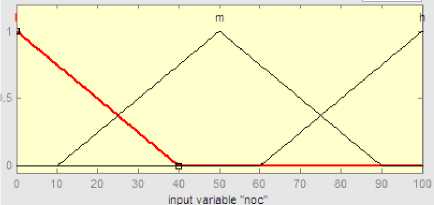
Fig.5. Number of Chunks
The number of chunks input variable having the range 0-100 is shown in the Fig 5. The mapping in Fig 5 shows the less than 40 are l chunks, 40-60 are m chunks and greater than 60 are h chunks.
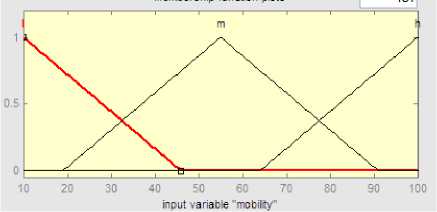
Fig.6. Mobility
The Mobility input variable having the range 10-100 is shown in the Fig 6. The Fig 6 denotes that mobility with rate less than 45m/s is l, 45-65 is m and greater than the 65 is h.
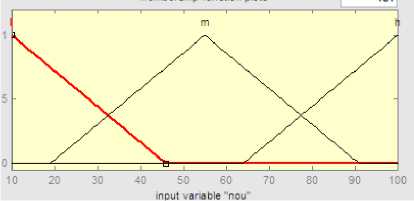
Fig.7. Number of Users
The number of users input variable having the range 10-100 is shown in the Fig 7. The number of users less than 45 are denotes by l in fuzzy, 45-65 as m and greater than 65 by the h linguistic variable. Here number of users plays a vital role in determining whether to adopt SDLAS or PDLAS scheme.
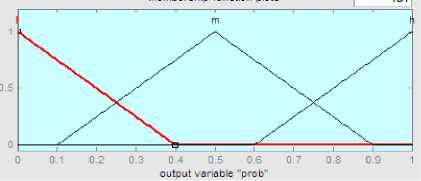
Fig.8. Selection Probability
The Selection probability is the output variable having the range 0-1 is shown in the Fig 8. If the probability is low than the physical value is less than 0.4 while m, h are denoted by 0.4-0.6 and greater than 0.6 respectively.
в=1.5 к=5е< mi=2“ пюйу=й prob=-C.i
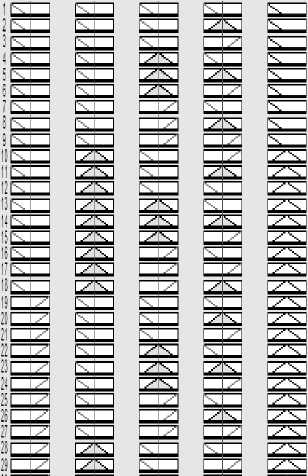
Total 81 rules exist in the fuzzy databases which are used to obtain output; some of them are shown below in the Fig 9.
The output of the fuzzy is used to select the SDLAS or PDLAS to transfer the data from one end to other. The process of the EDLAS is also described by the algorithm given below.
Algorithm for EDLAS:
-
1. Initialize network i.e. no of nodes, area, no of chunk(n),chunk size, mobility.
-
2. Request one chunk on each interface.
-
3. Calculate the throughput by using following formulae:
-
4. While n>0
-
5. Out= Use fuzzy to select the Parallel or the sequential
-
6. Update throughput
-
7. Calculate number of chunks to be transferred as number of chunks directly proportional to overall throughput that is calculated as
-
8. If out> 0.5 then Transfer data on p parallel connection
-
9. Calculate throughput.
-
10. n=n-N ch
-
11. End while
Th i (Ij ) = (N ch (Ij) * Ch size ) / RTD where N ch is the number of chunks to be transferred, Chsize is the chunk size and RTD is the round trip delay.
Th = Th - switching_cost, where switching_cost = const * Th * out where const = 0.5, out is output of the fuzzy.
Th ov (Ij) = Y * Th old (Ij) + (1- Y) * Th i (Ij) where Y=0.3.
Else transfer sequentially.
The Fig 10 discusses working of EDLAS technique. The working explained using the algorithm is given in the form of flowchart in Fig 10.
-
IV. Results And Discussion
The proposed technique EDLAS is simulated using the MATLAB. The technique is analyzed by considering various WI-FI access points, Femto base stations, Macro base Stations. The main assumption is that one macro base station region covers various Femtos and WI-FI access points. The fuzzy toolbox is used for the implementation of the fuzzy system. The remaining system is implemented by using the script file with extension .m in the MATLAB. The analysis parameters are throughput, delay and the remaining battery power. The throughput is the output of the system in the given interval of time. The delay is time required to transmit the data from source to the destination. The residual battery power shows the sum of the remaining energy in each node. It can be easily calculated by subtracting the total sum of all node energy from the sum of the all node initial energy. The reduction in the energy consumption means enhancement in residual energy i.e. enhanced network lifetime.

The results of the SDLAS, PDLAS and EDLAS are compared in the Fig 11 to Fig 13.
D e l a y
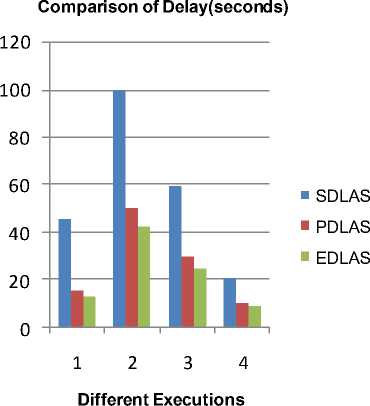
Fig.11. Comparison of Delay
Fig 11 shows the comparison of the delay taken to transfer the chunks. The graph of Fig 11 shows that the EDLAS technique takes minimum time to transfer the data as compared to SDLAS and PDLAS. It means the data is transferred from one end to other in less time. The time used for transferring the data gets reduced due to the intelligent usage of the sequential and the parallel scheme. The time reduction doesn’t lead to increase in the overhead.
Comparison of Throughput(kbps)
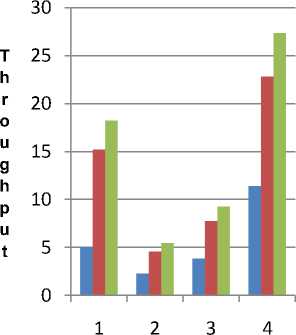
■ SDLAS
■ PDLAS
EDLAS
Different Executions
Fig.12. Comparison of Throughput
Fig 12 shows the comparison of the throughput of SDLAS, PDLAS and the EDLAS technique. The throughput of the PDLAS is better than the SDLAS, while the EDLAS technique show the maximum throughput. EDLAS technique shows approximate of 20% enhancement in the throughput of the PDLAS technique.
Comparison of Residual Battery Power
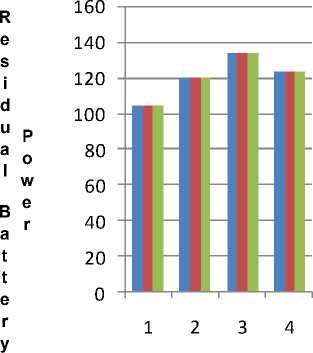
■ SDLAS
■ PDLAS
■ EDLAS
Different Executions
Fig.13. Comparison of Residual Battery Power
Fig 13 shows the comparison of the residual battery power. All techniques i.e. SDLAS, PDLAS as well as EDLAS consume same energy that’s why the residual battery power is same for all the techniques. It means the EDLAS technique transfer a large data in less time with same energy as compared to the SDLAS and the PDLAS technique. Here, the less time is observe by using the delay while the output is analyzed by the throughput. This shows the performance of the EDLAS technique is better than the existing PDLAS as well as the SDLAS technique.
-
V. Conclusion
A novel technique EDLAS has been presented in this paper to enhance the quality of service in the heterogeneous wireless network. The paper develops a generalized algorithm that works for heterogeneous network. The networks can be LTE, WI-FI etc. The paper also discusses the implementation of the technique by using the MATLAB. The implementation is done by considering the Femtos base station, Macro base station and the WI-FI access points. The parameters analyzed are throughput, delay and the residual battery power. The enhancement in the throughput is analyzed with the same remaining battery power. In future the technique can be enhanced by using the meta-heuristic techniques like PSO, BBO etc. The technique can also analyze on other different heterogeneous interfaces. The technique can also use other artificial intelligence technique to adapt according to the interface available.
Список литературы Enhancing Quality of Service in Heterogeneous Wireless Network using EDLAS
- Tomislav Shuminoski, Toni Janevski (2013) Radio Network Aggregation for 5G Mobile terminals in Heterogeneous Wireless Networks, in Telsiks 2013.
- Zhu, D., Mutka, M. W., & Cen, Z. (2004, October). QoS Aware Wireless Bandwidth Aggregation(QAWBA) by Integrating Cellular and Ad-Hoc Networks. In QSHINE (pp. 156-163).
- Sharma, P., Lee, S. J., Brassil, J., & Shin, K. G. (2004, October). Handheld routers: Intelligent bandwidth aggregation for mobile collaborative communities. In Broadband Networks, 2004. BroadNets 2004. Proceedings. First International Conference on (pp. 537-547). IEEE.
- Gupta, B. K., Lal, M., & Sharma, S. C. (2005, November). Improving quality of service parameters in wireless asynchronous transfer mode network. In Mobile Technology, Applications and Systems, 2005 2nd International Conference on(pp. 1-8). IEEE.
- Saliba, A. J., Beresford, M. A., Ivanovich, M., & Fitzpatrick, P. (2005). User-perceived quality of service in wireless data networks. Personal and Ubiquitous Computing, 9(6), 413-422.
- Chebrolu, K., & Rao, R. R. (2006). Bandwidth aggregation for real-time applications in heterogeneous wireless networks. Mobile Computing, IEEE Transactions on, 5(4), 388-403.
- Romaszko, S., & Blondia, C. (2006). Dynamic distributed contention window control in wireless ad hoc LANs. In Proceedings of the Australian Telecommunication Networks and Applications Conference (ATNAC 06), Melbourne, Australia.
- Patil, S., & de Veciana, G. (2007). Managing resources and quality of service in heterogeneous wireless systems exploiting opportunism. IEEE/ACM Transactions on Networking (TON), 15(5), 1046-1058.
- Jin, N., & Jordan, S. (2008). On the feasibility of dynamic congestion-based pricing in differentiated services networks. IEEE/ACM Transactions on Networking (TON), 16(5), 1001-1014.
- Elias Z. Tragos and George Tsiropoulos (2008) Admission Control for QoS Support in Heterogeneous 4G Wireless Networks, in IEEE Network • May/June 2008
- Kirubakaran, S., & MANOHARAN, D. C. (2010). Reducing Packet Delay and Loss in Heterogeneous Mobile Wireless Networks. Global Journal of Computer Science and Technology, 9(5).
- Mairh, A., & Pati, H. K. (2011, February). Quality-of-service at data link layer in wireless cellular networks. In Proceedings of the 2011 International Conference on Communication, Computing & Security (pp. 162-165). ACM
- Jha, R. K., Limkar, S. V., & Dalal, U. (2011, February). A Performance comparison for QoS with different WiMAX environment for video application. InProceedings of the International Conference & Workshop on Emerging Trends in Technology (pp. 785-790). ACM.
- MALA, K. S., & NAVANEETHAN, P. (2012). TCP-WLAware: Wireless Loss-Aware TCP for IEEE 802.16 Networks. WSEAS Transactions on Communications, Volume11 Issue(12).
- Mansouri, W., Zarai, F., Mnif, K., Obaidat, M. S., & Kamoun, L. (2013, June). End-to-end delay distribution in wireless heterogeneous networks. In Communications (ICC), 2013 IEEE International Conference on (pp. 2969-2973). IEEE.
- Jun Huang, (2014) Guaranteeing End-to-End Quality-of-Service with A Generic Routing Approach, Applied Computing Review JUN. 2014, VOL. 14, NO. 2.
- Bui, D. H., Lee, K., Oh, S., Shin, I., Shin, H., Woo, H., & Ban, D. (2013, December). GreenBag: energy-efficient bandwidth aggregation for real-time streaming in heterogeneous mobile wireless networks. In Real-Time Systems Symposium (RTSS), 2013 IEEE 34th (pp. 57-67). IEEE.
- Bala Murali Krishna K, Madhuri S, Vanlin Sathya and Bheemarjuna Reddy Tamma, (2014) A Dynamic Link Aggregation Scheme for Heterogeneous Wireless Networks, IEEE CONECCT2014 1569825269.

